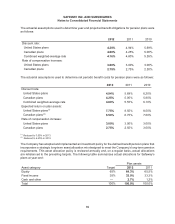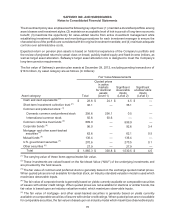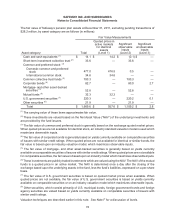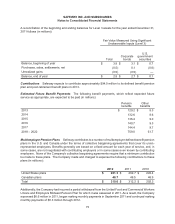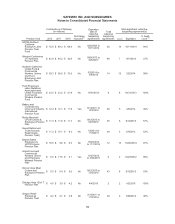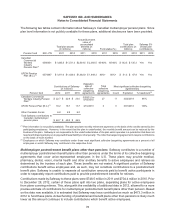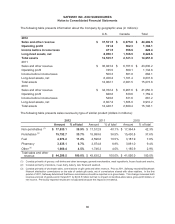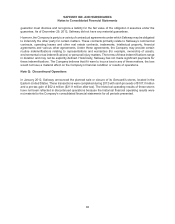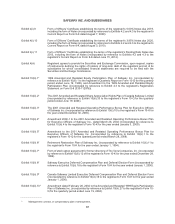Safeway 2012 Annual Report Download - page 91
Download and view the complete annual report
Please find page 91 of the 2012 Safeway annual report below. You can navigate through the pages in the report by either clicking on the pages listed below, or by using the keyword search tool below to find specific information within the annual report.SAFEWAY INC. AND SUBSIDIARIES
Notes to Consolidated Financial Statements
79
There have been no significant changes that affect the comparability of 2012, 2011 or 2010 contributions,
other than the availability of additional data for 2012, as previously described.
Note L: Investment in Unconsolidated Affiliates
At year-end 2012, 2011 and 2010, Safeway’s investment in unconsolidated affiliates includes a 49%
ownership interest in Casa Ley, which operated 195 food and general merchandise stores in Western Mexico
at year-end 2012.
Equity in earnings from Safeway’s unconsolidated affiliates, which is included in other income, was income
of $17.5 million in 2012, $13.0 million in 2011 and $15.3 million in 2010.
Note M: Commitments and Contingencies
Legal Matters The Company is subject from time to time to various claims and lawsuits arising in the
ordinary course of business, including lawsuits involving trade practices, lawsuits alleging violations of state
and/or federal wage and hour laws (including alleged violations of meal and rest period laws and alleged
misclassification issues), real estate disputes and other matters. Some of these suits purport or may be
determined to be class actions and/or seek substantial damages.
It is management's opinion that although the amount of liability with respect to certain of the above matters
cannot be ascertained at this time, any resulting liability of these and other matters, including any punitive
damages, will not have a material adverse effect on the Company's financial statements taken as a whole.
Commitments The Company has commitments under contracts for the purchase of property and
equipment and for the construction of buildings, marketing development funds, the purchase of energy and
other purchase obligations. Portions of such contracts not completed at year end are not reflected in the
consolidated financial statements. These purchase commitments were $553.9 million at year-end 2012.
Note N: Segments
Safeway’s retail business, which represents approximately 98% of consolidated sales and other revenue,
operates in the U.S. and Canada. Safeway is organized into 11 geographic retail operating segments
(Chicago, Denver, Eastern, Northern California, Phoenix, Northwest, Texas, Vons, Alberta, Vancouver and
Winnipeg). Across all 11 retail operating segments, the Company operates primarily one store format, where
each store offers the same general mix of products with similar pricing to similar categories of customers.
Safeway does not operate supercenters, warehouse formats, combination clothing/grocery stores or discount
stores.
These 11 operating segments and other immaterial segments have been aggregated into one reportable
segment because, in the Company’s judgment, the operating segments have similar historical economic
characteristics and are expected to have similar economic characteristics and similar long-term financial
performance in the future. The principal measures and factors we considered in determining whether the
economic characteristics are similar are gross margin percentage, operating profit margin, sales growth,
capital expenditures, competitive risks, operational risks and challenges, retail store sales, costs of goods
sold and employees. In addition, each operating segment has similar products, similar production processes,
similar types of customers, similar methods of distribution and a similar regulatory environment. The Company
believes that disaggregating its operating segments would not provide material or meaningful additional
information.


